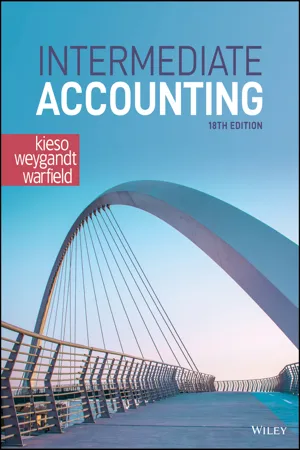
- 1,616 pages
- English
- PDF
- Available on iOS & Android
Intermediate Accounting
About this book
Intermediate Accounting by Donald Kieso, Jerry Weygandt, and Terry Warfield has always been, and continues to be, the gold standard. Through significant updates, the 18th Edition presents a refreshed, accessible, and modern approach with new perspectives that help connect students to the what, the why, and the how of accounting information.
In the intermediate accounting course, it can be difficult for students to understand the technical details and retain and recall core course topics. To move beyond basic understanding, students work through new integrated practice right at the point of learning and high-quality assessment at varying levels, helping them to learn concepts more efficiently and create connections between topics and real-world application.
Throughout the course, students also work through various hands-on activities including Critical Thinking Cases, Excel Templates, and Analytics in Action problems, all within the chapter context. These applications help students develop an accounting decision-making mindset and improve the professional judgement and communication skills needed to be successful in the profession.
With Intermediate Accounting, 18th Edition, you will be able to spark efficient and effective learning, help create the bridge to student success, and inspire and prepare students to be the accounting professionals of tomorrow.
Frequently asked questions
- Essential is ideal for learners and professionals who enjoy exploring a wide range of subjects. Access the Essential Library with 800,000+ trusted titles and best-sellers across business, personal growth, and the humanities. Includes unlimited reading time and Standard Read Aloud voice.
- Complete: Perfect for advanced learners and researchers needing full, unrestricted access. Unlock 1.4M+ books across hundreds of subjects, including academic and specialized titles. The Complete Plan also includes advanced features like Premium Read Aloud and Research Assistant.
Please note we cannot support devices running on iOS 13 and Android 7 or earlier. Learn more about using the app.
Information
Table of contents
- Cover
- Title Page
- Copyright
- Brief Contents
- From the Authors
- About the Authors
- New to This Edition
- Reimagined Pedagogy
- Data Analytics
- Engaging Online Student Resources and Tools
- Student Assessment
- Preparing for the CPA Exam
- Acknowledgments
- Table of Contents
- Chapter 1: The Environment and Conceptual Framework of Financial Reporting
- Chapter 2: The Accounting Information System
- Chapter 3: Income Statement, Related Information, and Revenue Recognition
- Chapter 4: Balance Sheet and Statement of Cash Flows
- Chapter 5: Accounting and the Time Value of Money
- Chapter 6: Cash and Receivables
- Chapter 7: Valuation of Inventories: A Cost-Basis Approach
- Chapter 8: Inventories: Additional Valuation Issues
- Chapter 9: Acquisition and Disposition of Property, Plant, and Equipment
- Chapter 10: Depreciation, Impairments, and Depletion
- Chapter 11: Intangible Assets
- Chapter 12: Current Liabilities and Contingencies
- Chapter 13: Long-Term Liabilities
- Chapter 14: Stockholders’ Equity
- Chapter 15: Dilutive Securities and Earnings per Share
- Chapter 16: Investments
- Chapter 17: Revenue Recognition
- Chapter 18: Accounting for Income Taxes
- Chapter 19: Accounting for Pensions and Postretirement Benefits
- Chapter 20: Accounting for Leases
- Chapter 21: Accounting Changes and Error Analysis
- Chapter 22: Statement of Cash Flows
- Chapter 23: Full Disclosure in Financial Reporting
- Appendix A: Private Company Accounting
- Appendix B: Specimen Financial Statements: The Procter & Gamble Company
- Appendix C: Specimen Financial Statements: The Coca-Cola Company
- Appendix D: Specimen Financial Statements: PepsiCo, Inc.
- Company Index
- Subject Index
- Intermediate Accounting 18E: List of Accounts
- EULA